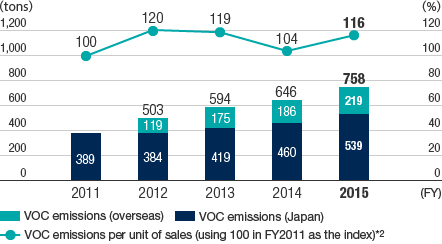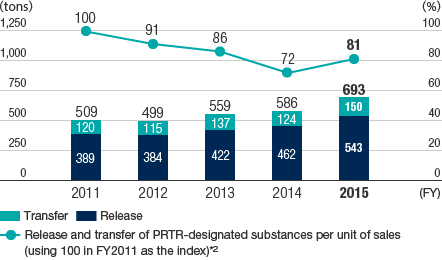KUBOTA Worldwide
Controlling Chemical
Substances
| Chemical substances may cause environmental pollution unless they are controlled properly. The KUBOTA Group continuously works to address proper control and reduction goals for chemicals. |
Controlling Chemical Substances
| 1. | The targets of the Medium-Term Environmental Conservation Plan for FY2016 and the results for FY2015 |
| Issues | Actions | Management Indicators*2 | Scope | Base FY |
Targets FY2016 |
Results FY2015 |
*3 Self- evaluation |
Achievement Status |
| Controlling chemical substances | Reduction of VOCs*1 | VOC emissions per unit of production | Global Production | 2009 | -21% | -29.4% |  |
We are making progress on VOC reduction by improving coating efficiency and use of non-VOC paints. |
| *1 | VOCs comprise the six VOCs that are most prevalent in emissions from the KUBOTA Group: xylene, toluene, ethylbenzene, styrene, 1, 2, 4-trimethylbenzene, and 1, 3, 5-trimethylbenzene. |
| *2 | The figures per unit of production represent the intensity of the environmental load per unit of production money amount. The exchange rate of the base fi scal year is used when translating the production value of overseas sites into yen. |
| *3 | Self-evaluation rating symbols:  Target exceeded (by at least 20%) Target exceeded (by at least 20%)  Target reached Target reached  Target not yet reached. Target not yet reached. |
| 2. | Trends of VOC emissions and emissions per unit of sales |

|
|
| *1 | VOCs comprise the six VOCs that are most prevalent in emissions from the KUBOTA Group: xylene, toluene, ethylbenzene, styrene, 1, 2, 4-trimethylbenzene, and 1, 3, 5-trimethylbenzene. |
| In FY2015, volatile organic compound (VOC) emissions were 758 tons, an increase of 17.4% compared to the previous fiscal year. We made efforts to reduce VOCs such as improving painting effectiveness and switching to VOC-free materials. However, VOC emissions increased owing to increasing production at Japan cast iron production sites and overseas production sites. Additionally, the VOC emissions per unit of sales increased 11.6%. | |
| 3. | Trends of release and transfer of PRTR-designated substances, release and transfer per unit of sales |

|
|
| *1 | Total amount of declarable substances that are handled at each site (annual volume of 1 ton or more (0.5 ton for Specific Class I designations)) |
| *2 | Release and transfer of PRTR-designated substances per unit of consolidated net sales. |
| In FY2015, a total of 693 tons of substances stipulated in the PRTR Law* was released and transferred, an increase of 18.2% compared to the previous fiscal year. Additionally, the release and transfer per unit of sales increased 12.4% compared to the previous fiscal year. | |
Controlling chemical substances contained in products
| 1. | Response to the REACH regulation |
| As a response to the REACH Regulation*1, the KUBOTA Group has established and enforced rules to identify the chemical substances contained in our products and ensure its appropriate control. Since FY2011, the Group has categorized chemicals contained in products into the three control levels listed below. The Group also undertakes researches on chemicals contained in products on a global basis, with support from our suppliers. *1 REACH Regulation: EU’s Regulation for Registration, Evaluation, Authorisation and Restriction of Chemicals - Control levels - 1. Substances to be Prohibited; Should not be contained in products 2. Substances to be Restricted; Should not be contained in products under certain conditions and applications 3. Substances to be Controlled; Their presence in products should be recognized |






